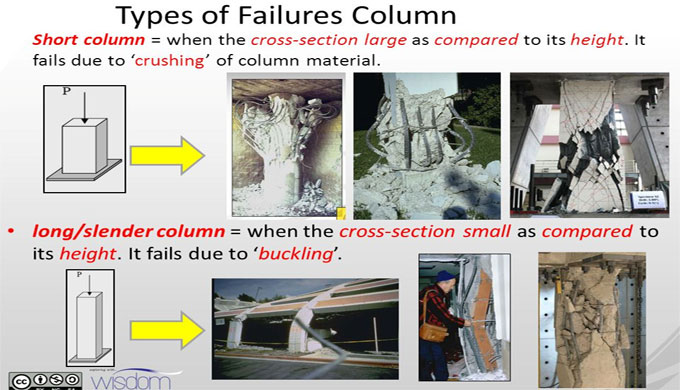
Concrete Column Failure Types
The classification of column is done on the basis of its height. Each material in the building undergoes both compression and tension stress and the design of the modern buildings depends on this stress.
There are two important materials in the columns like concrete and steel. Architects perform calculation of the total stress resulting from the live and dead load of the whole building and based on it, the design the internal components (foundation, beam, and columns) of the building is created. Therefore, when the applied stress goes beyond the permissible stress (calculated) then there is possibility for collapsing of the structures.
The following types of column failure are normally found :-
1. Compression Failure
2. Buckling Failure
3. Shear Failure
1. Compression Failure: When columns are axially loaded, the concrete and steel will undergo some stresses. When there are extreme loads with regard to the cross-sectional area of the column, the concrete and steel will attain the yield stress and failure occurs devoid of any later deformation. Under this type of failure, the material collapses itself, without entire column.
This type of failure is frequently observed in shorter and wider columns. To get rid of this problem, the column should be constructed with adequate cross-sectional area in respect of the permissible stress.
2. Buckling Failure: Buckling failure is mostly found in long columns since they are very slender and their minimum lateral dimension is in excess of 12. Under such situation, the load bearing strength of the column is reduced significantly.
The columns are likely to be unsteady and start buckling to side ward when small loads are applied on them. It signifies that the concrete and steel have attained their yield stress for even small loads and start collapsing because of lateral buckling. To get rid of this type of failure, the long columns with slenderness ratio more than 30, should not be erected.
3. Shear Failure: The shear strength refers to the strength of a material or element against the type of yield or structural failure where the material or element collapses in shear. A shear load stands a force that is likely to develop a sliding failure on a material along a plane that is parallel to the direction of the force.
To get more clear ideas, go through the following video presentation.
Video Source: Civil Mentor


